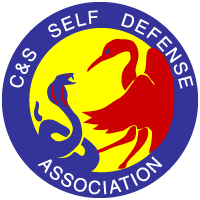
|
C&S Online
An Online Newsletter For The
C&S Self Defense Association
Fall 2003
Confidence. Fitness. Success.
|
|
Featured Articles...
|
The Budo Concept of Shu Ha Ri
Yondan Kerry Bushue, 4th Degree Black Belt
Personal Protection Agency, Tyler, TX
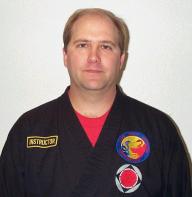 The budo concept "shu, ha, ri" has three phases of transition from beginner to master, to imitate, diverge and transcend. Not confined to the study of a martial art or way, it serves as a model for learning. Describing a general principle by which tradition and knowledge is transmitted, it can be applied to a broad range of physical, intellectual, and metaphysical endeavor in order to develop specific satori, or moments of enlightenment. Indoctrinated within a specific set of practices, it is a circular process by which the individual develops their own understanding of those practices and ultimately moves beyond those specific practices while still recognizing the value of the process by which they learned. Simply applied, it describes the process by which an individual learns, innovates and transcends the traditions associated with a particular set of practices.
The budo concept "shu, ha, ri" has three phases of transition from beginner to master, to imitate, diverge and transcend. Not confined to the study of a martial art or way, it serves as a model for learning. Describing a general principle by which tradition and knowledge is transmitted, it can be applied to a broad range of physical, intellectual, and metaphysical endeavor in order to develop specific satori, or moments of enlightenment. Indoctrinated within a specific set of practices, it is a circular process by which the individual develops their own understanding of those practices and ultimately moves beyond those specific practices while still recognizing the value of the process by which they learned. Simply applied, it describes the process by which an individual learns, innovates and transcends the traditions associated with a particular set of practices.
Shu literally means to protect or maintain and represents learning from tradition. This is the way the chain of tradition is perpetuated and passed on. The shu stage stresses basics so the student has a solid foundation for future learning. A comprehensive understanding of foundational basics, is an indispensable step on the infinite ladder of growth and development in karatedo.
Repetitious practice emulating the instruction given, tempers the mind and body to absorb the lessons being taught. An internalization of the principles and information happens as the shu stage is nearly complete and one enters the Ha stage. There are no time limits for each of the three stages, and transition from one level to the next is neither simple nor immediate. Rather, levels tend to overlap each other in the transition phase, which allows for a gradual withdrawal from one level and a subtle entry into to the next plane.
`Ha' literally means `to detach' and refers `to breaking free the chains of tradition'. Even though, it does not mean to depart from that which has given us strength, it does represent a transitional phase from which a person emerges strengthened through the power of introspection. The supreme power of one's mind is first realized when the focal point of meditation explores the `world within'. Reflecting on the meaning and purpose of everything that has been learned, one comes to a deeper understanding of the art.
By discovering and questioning through personal experience, one breaks free of the rigid instruction and goes to a deeper level. At this stage, since each technique is thoroughly learned and absorbed into the muscle memory, exploring the background behind the technique is essential. Furthermore, individuality will begin to emerge as techniques are performed. Every aspect of one's life, their understanding of karatedo, daily training, and life itself, takes on a completely new meaning as one continues a relentless pursuit to the next phase of mastery.
Ri the final stage of transition, literally means to go beyond or transcend. This is commonly referred to as enlightenment or spiritual liberation. Relentless conditioning, deep introspection, and experience over time form the foundation to stand on new ground that is being explored in an original way. One discovers a new world by looking deep within and discovering the inner self.
Learning and progressing more through self-discovery than by instruction one has an outlet for creative impulses. Furthermore, the imprint of the techniques reflects ones own personality and character. In this final stage, independence is inevitable, although one is now fully independent, one treasures the wisdom and patient counsel of their teacher and there is a richness to the relationship that comes through their shared experiences.
Shu Ha Ri is not a linear progression. It is more similar to concentric circles, so that there is Shu within Ha and both Shu and Ha within Ri. Thus, the fundamentals remain constant; only the application of them and the subtleties of their execution change. Ultimately, Shu Ha Ri should result in one surpassing their master, both in knowledge and skill. If one never surpasses their master, then the art will stagnate, at best. If one never achieves the master's ability, the art will deteriorate. But, if one can assimilate all that the master can impart and then progress to even higher levels of advancement, the art will continually improve and flourish.
4th Degree Black Belt Yondan Kerry Bushue is the Head Instructor for the Personal Protection Agency in Tyler, TX. He began his martial arts training in 1980 with Master David Landers of Effingham, Il. He moved to Orange, Texas in 1987, and is currently living in Lindale, TX. Yondan Bushu can be reached at KDBushue@hotmail.com.
Top | Front Page | Board | Featured | Happenings | Views | Back Page | C&S Home
|
Beginning Chi-Sau
Grandmaster Peter Rose
Rose School of Karate, Portsmouth, NH
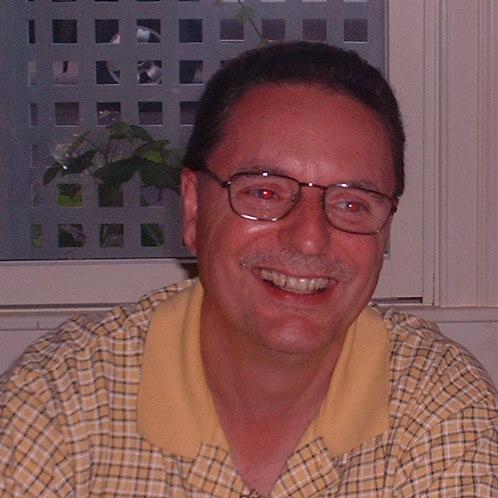 Beginning Chi-Sau
When I teach Chi-Sau to a new student — after all of the basics of the exercise are explained — there are 3 main technical concepts that I want to be sure they understand:
Beginning Chi-Sau
When I teach Chi-Sau to a new student — after all of the basics of the exercise are explained — there are 3 main technical concepts that I want to be sure they understand:
- Stay engaged
- Force redirection
- Body centered force flow
Starting out, I show them how to move both arms in the same circular direction vs. different directions. This is to make it easy for the student to get the general hang of the exercise. Once they can do that and remain in a good stance (i.e. "long dragon"), they are ready to learn the concept of staying "engaged".
Staying engaged simply means not letting their arm lose contact with my arm as we sweep in gentle arches. There is always a hesitancy in doing this. The new student feels that they move with you and then catch up with a sharp move. But, of course, my arm is no longer there for them to catch up to. My hand is planted on their chest. So they pay attention to how to "stay engaged". Light — not hard or pushy, but firm — contact with the arm is the key. But the contact is firm and done with the spirit — the chi — rather than with the body.
Once the student understands what they are supposed to be doing, I just work with one arm at a time so they can better focus on staying engaged with my arm. We move in gentle sweeping arches until they "stick" with me. Most are able to quickly see results and we move on to doing this with both arms, but still in parallel arcs.
When the student begins to "push back" at the right time to stay engaged, it is then time to demonstrate the concept of force redirection. As the arms continue to sweep in arcs, I begin to move the students arm all over the place. They happily follow until they find that hand on their chest again. I explain that they cannot always allow me to direct them; that they must sense where I am going and though going "with it", they must somehow "redirect" my arm in a direction different than where I was taking them. They learn right away that they cannot apply force to this, or the hand will be on their chest. They must learn to sense the flow and wait until that flow will easily allow them to redirect my arm in another direction.
The I-Ching speaks of this in hexagram 64 "Before Completion":
"The caution of a fox walking over ice is proverbial. His ears are constantly alert to the cracking of the ice, as he carefully and circumspectly searches out the safest spots. A young fox who as yet has not acquired this caution goes ahead boldly, and it may happen that he falls in and gets his tail wet when he is almost across the water. Then of course his effort has been all in vain. Accordingly, in times 'before completion', deliberation and caution are the prerequisites of success."
As the student begins to take more control of the exercise rather than letting me direct them, I offer them the concept of body centered force flow. This is how the student can begin to put a feeling to their understanding of what the "chi" is. The combination of engagement and force redirection bring them smoothly to where they can now experience for the first time their own chi as it flows from their physical center and spirit and manifests itself up from their rooting on the floor, through their hips, and lower body, and out through their arms. It is a tremendous feeling of satisfaction. And when taught well, the instructor always sees the chi glow in the students eyes. It is the bright light of hope and accomplishment. Chi-Sau now belongs to the student.
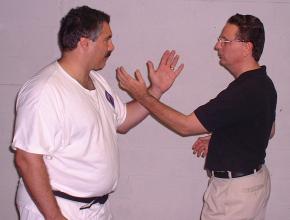
Beginning with just one arm at a time, the principle of engagement is explained.
|
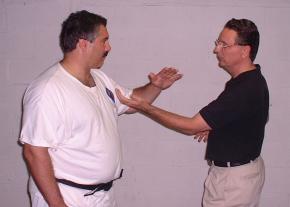
Here, I show the student what happens when they allow disengagement to happen. Contact is broken, and there is no way of knowing where the opponent is or what he is doing.
|

The next step is to work with both arms.
|
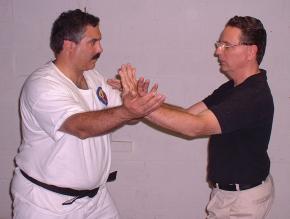
I begin to lead the student through a slow circular sweep of both arms.
|
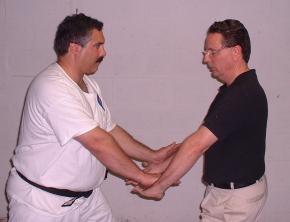
As the student becomes more experienced, the bottom of this sweep becomes an important transition point as will be seen in the following picture.
|

I have changed the circular sweep with both arms into moving each arm in a different direction. This requires great concentration to keep engaged through these different arching patterns.
|
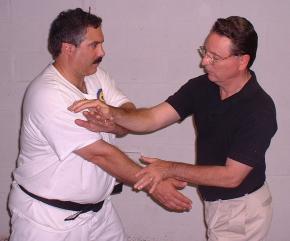
Finally, I show the student a "cross over". This is a technique where as the lower arm increases engagement pressure to distract the opponent, the upper arm almost seems to float but, in fact, pressure is translated in a different direction in a very subtle manner such that I end up tying the opponent's arms in a knot. I can then go for either an off ballancing movement, or a strike.
|
Grandmaster Peter M. Rose holds an 8th Degree Black Belt. He began his studies with Grandmaster S.A. Brock in 1968. He has operated the Rose School of Karate in Portsmouth, NH since 1972. Grandmaster Rose is a senior software engineer, analyst, designer, and technical project manager. Grandmaster Rose can be reached at zzrose@yahoo.com, or you can visit his personal web site http://www.zzrose.com/pmr.html.
Top | Front Page | Board | Featured | Happenings | Views | Back Page | C&S Home
|
Happiness
Yondan Bruce Vinciguerra, 4th Degree Black Belt
Somersworth School of Self Defense, Somersworth, NH
 Aristotle said that, "Happiness is the meaning and purpose of life, the whole aim and end of human existence."
Aristotle said that, "Happiness is the meaning and purpose of life, the whole aim and end of human existence."
If Happiness is the ultimate goal in our life then why is it that so many people seem unhappy? I believe that most people have never tried to define what happiness really is. Society inundates us with believing that buying the right car, soda, toothpaste etc., is necessary to bring happiness to us. How often do you hear or do you catch yourself saying something like, "If I only had a new car.", or "If I only had a new job that would make me happy." Many believe that by getting something their life will be better only to find that they are never satisfied.
People often confuse the difference between pleasure and happiness. Happiness is not pleasure although the two can appear similar. Pleasure is enjoyment from an outside stimulus. You might find pleasure in buying something, going on vacation or having friends over, etc. The list of things you might enjoy experiencing is long. Pleasure requires an outside stimulus for you to experience it, happiness does not. Happiness is a belief about yourself and the outside world. Pleasure is born from the outside world; happiness is born from the internal workings of our mind.
If happiness is what we want, what keeps us from being happy? Here is a list of only some emotions and feelings that keep us from being happy- Self doubt, depressed, hateful, fearful, worried, unsatisfied, bored, grief, shame, guilt, and discontent, anxious, angry, irritated, stressed, frustrated, upset, sad, envious and jealous. Now if you look closely to these emotions we all tend to choose to feel them. Life is challenging and how we view the events in our life can determine our level of happiness. Everything is about perspective. How many times have you seen two people go through the same exact event and each feel differently about it? The event is the same so how did they see it differently? Each had a different perspective. If we can recognize this as being true and we are unhappy then we have to change our perspective of the world we live in.
Our Art recognizes this and one major tool that we have and share with students and ourselves is Basic Self Realization Training. The purpose of this training is to begin to train our mind to become who we would like to become. Happiness begins with a conscious decision to be happy. Most people who hear the philosophy of BST says that it seems obvious. I agree that it is obvious; the problem is that I do not think people take it seriously. Can you be happy just by saying you are happy? No, the point is that you are telling yourself that you want to be happy, you are training your mind and that sets you on the path to begin to notice how you are thinking. It makes you look at ways in which you can become a happier person. We all have choices and we choose what our perspective is to any event. The more you strive to be happy, the more you will find yourself seeing the world differently.
Remember that pleasure comes from an outside stimulus and happiness is born from the internal workings of the mind. Happiness is a belief about yourself and the outside world. How you view yourself and your life determines your state of happiness. I believe that when you can say and believe that life is good then you are in a state of being happy.
4th Degree Black Belt Yondan Bruce Vinciguerra is the head instructor of the Somersworth School of Self Defense in Somersworth, NH. He is a Canemaster in the Cane Masters International Association. He owns Tony's Television where they specialize in the repairs of Video and Audio Equipment. He is married with 3 children and has been training in the Art since 1983. He can be reached at sensei@ssosd.com.
Top | Front Page | Board | Featured | Happenings | Views | Back Page | C&S Home
|
Website design by Peter Rose, zzrose@yahoo.com
|

 The budo concept "shu, ha, ri" has three phases of transition from beginner to master, to imitate, diverge and transcend. Not confined to the study of a martial art or way, it serves as a model for learning. Describing a general principle by which tradition and knowledge is transmitted, it can be applied to a broad range of physical, intellectual, and metaphysical endeavor in order to develop specific satori, or moments of enlightenment. Indoctrinated within a specific set of practices, it is a circular process by which the individual develops their own understanding of those practices and ultimately moves beyond those specific practices while still recognizing the value of the process by which they learned. Simply applied, it describes the process by which an individual learns, innovates and transcends the traditions associated with a particular set of practices.
The budo concept "shu, ha, ri" has three phases of transition from beginner to master, to imitate, diverge and transcend. Not confined to the study of a martial art or way, it serves as a model for learning. Describing a general principle by which tradition and knowledge is transmitted, it can be applied to a broad range of physical, intellectual, and metaphysical endeavor in order to develop specific satori, or moments of enlightenment. Indoctrinated within a specific set of practices, it is a circular process by which the individual develops their own understanding of those practices and ultimately moves beyond those specific practices while still recognizing the value of the process by which they learned. Simply applied, it describes the process by which an individual learns, innovates and transcends the traditions associated with a particular set of practices.








 Aristotle said that, "Happiness is the meaning and purpose of life, the whole aim and end of human existence."
Aristotle said that, "Happiness is the meaning and purpose of life, the whole aim and end of human existence."